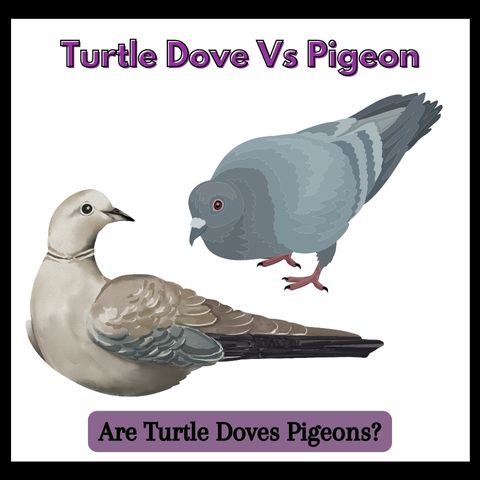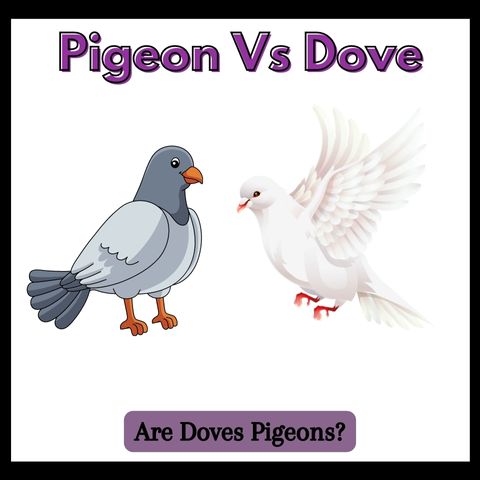Rock Dove Vs Pigeon: 5 Key Differences & How to Identify
When bird watching, it is not uncommon to mistake any Bird’s identity for one another, leading to confusion among observers. In such instances, if we encounter any rock dove when bird watching, we often confuse It with a pigeon. In this article, I will help you explore five key differences between rock dove vs pigeon to help you understand how to tell them apart confidently & accurately. In this article, I have covered everything from the physical characteristics to their vocalization & ranges. We have got it all covered here, so read this article thoroughly.
Table of Contents
Rock Doves vs Pigeons: 5 Key Differences Between

Rock Dove Vs Pigeon: Morphological Differences
| Characteristic | Rock rock dove(Columba livia) | Pigeon (Columba livia) |
| Size | Larger, around 32 cm | Slightly smaller, around 29 cm |
| Body Shape | Robust | Streamlined & slender |
| Color | Varies, often light gray | Diverse coloration, including shades of gray, white, & brown |
When it comes to understanding the physical appearance of both the species pigeon & rock dove, both exhibit some noticeable distinctions & differences. The Rock doves are said to be larger & bulkier compared to pigeons, with an average length of 32 CM. At the same time, the pigeons will appear slightly smaller measuring around 29 CM.
After Researching various websites & articles, I can confidently say that a pigeon will have a more streamlined & slender body compared to the robust build of doves. Also, you should note that doves are said to be the wild ancestors of domesticated pigeons.
Rock Dove Vs Pigeon: Behavioral Differences
If you look at the behavior of both species, there are also several differences between rock doves vs pigeons. In general, doves are known to feed on seeds & grains, and their foraging behavior is strictly seen on the ground. Also, doves bob their heads while walking, making them quite different from other species, especially pigeons, known for their smooth walk.
On the other hand, pigeons have adapted well to urban ecosystems & are commonly noticed foraging for food near human settlements. The Oxford Academic conducted a study on the pigeon and found that pigeons are quite highly socially bird & tend to move on in flocks, especially in areas with abundant food sources.
Rock Dove Vs Pigeon: Vocalization & Sounds
Another way to tell both species apart is their vocalization & sounds. Both the species, pigeons & doves, are known for their distinctive vocalization. You will find rhythmic, repetitive cooing sounds if you hear doves, whereas pigeons emit a softer or purring sound. I learned about a research paper published in the National Institutes of Health (.gov). It was stated that these vocalizations have various communication purposes for Avian creatures, like attracting mates & establishing territory.
Rock Dove Vs Pigeon: Range & Distribution
Another way to tell them apart is to look at the range of distribution of this bird. Yes, the habitat & migratory pattern of these birds will provide you with some valuable insights. Doves are native to Europe, North Africa, & South Asia, but later, they were also introduced for other reasons by humans. Now, you can find doves on every continent except Antarctica & we know why.
A study published in the Journal of NatureMapping Foundation found rock doves’ widespread distribution is a result of successful introduction & adaptation in the early 1600s. On the other hand, pigeons are known for being more adaptable have & popular for their global distribution. You can find pigeons everywhere, from bursting cities to remote islands; pigeons have managed to establish populations in various ecosystems.
While studying, I also learned about the study from the ResearchGate, which shows that pigeon carriers have a remarkable ability to thrive in diverse environments due to their flexibility in feeding & nesting habits. It is common to spot pigeon nests in urban settings, especially on balconies or your roof. Suppose a high population of pigeons also surrounds your area. In that case, you should consider reading my recent article on How To Stop Pigeons Nesting under solar panels or How to Get Rid of Pigeon Nests. But, before you get rid of any pigeon nest, make sure to understand ‘What Happens If You Destroy a Pigeon Nest‘ as well as ‘Why Are Pigeon Nests So Bad.
Rock Dove Vs Pigeon: Genetics & Taxonomy
Genetic studies can also help you learn interesting insights into the relationship between pigeons & rock doves. According to a research paper by the Cornell University, pigeons & rock doves have exhibited genetic drift variations despite their morphological similarities, which can help us distinguish between both species. The genetic differences are quite significant to classify them into various subspecies, which will further help us understand their genetic differences & similarities to gain a comprehensive understanding of evolutionary history & ecological adaptations.
How to Identify Rock Doves & Pigeons

Since it is common to get confused between rock doves vs pigeons, you must keep an eye on & pay attention to careful observation of their physical traits, behavior, & vocalization to identify pigeons & rock doves. Below I’m mentioning some practical tips that can help you confidently differentiate between rock doves and pigeons.
Physical Identification
First, if you look at the size & body shape of both birds, you will find some notable differences: Rock doves are known to have larger bodies with a more robust appearance than pigeons’ slimmer appearance. Also, rock doves will display a mix of light grey & darker shades, whereas pigeons are known for their varieties of color, including grey, white, & brown. Also, never mind observing their head movement while walking because if the bird is bobbing their head, you are looking at the dove. Pigeons will generally move with a smoother gate.
Behavioral Identification
Also, social & feeding behavior can provide valuable insights into pigeons vs rock doves. You should take note of the foraging habit of both species because if the bird only eats seeds & grains over other food, it is likely to be a dove often seen on the ground. On the other hand, pigeons will scavenge near human settlements for food. Also, pigeons are known for being friendly and love to move in flocks, whereas rock doves are less gregarious. So make sure you also note their flocking pattern to tell both species apart accurately & confidently.
Vocal Identification
Another thing that can help you is the vocal identification of both the bird. If you listen there a cooing sound, you will find rock doves producing rhythmic repetitive coos compared to softer and more repetitive sounds or calls of pigeons.
Common Misconceptions & Myths
Rock Doves are a Different Species than Pigeons
First, it is a widespread misconception that pigeons & doves are entirely different species. As I told you earlier, both species come from the same family. Doves are known to be a wild ancestor of domesticated pigeons. The distinction usually lies in their subspecies & regional variations, which might lead to confusion.
Rock Doves Carry Diseases
Even though both the species pigeon & doves are known to transmit certain infections, which have already confirmed that the risk of contracting diseases from these avian friends is relatively lower, it is quite a common belief that pigeons & doves are disease carriers. However, it happens when you don’t maintain proper hygiene practices or keep a safe distance from their droppings to minimize potential health risks.
3 Tips for Birdwatchers & Enthusiasts
- Best Places to Spot Rock Doves & Pigeons: If you are very interested in watching these creatures, I will advise you to visit coastal cliffs or areas with abundant rocky terrains to spot doves. To observe pigeons, visit urban environments with ample food sources & human presence, for example, parks.
- Attracting Rock Doves & Pigeons to Your Garden: A few ways exist to create a bird-friendly environment that will further attract pigeons & rock doves to your garden. You should consider providing bird feeders with seeds & grains in addition to shallow water dishes for drinking & bathing.
- Ethical Observing & Interaction: If you are like me, a nature lover & appreciator, I will advise you to maintain a safe distance and respectful distance to avoid disturbing our little avian friends’ natural behavior or habitat. When bird watching, you should always refrain from feeding them human food as it can harm their health.
Conclusion
Even though pigeons & rock doves have some similarities, some distinct characteristics set them apart. I have given my best to give you some key differences in terms of their morphology, behavior, vocalization, and distribution to help you identify & tell them accurately & confidently. During my bird-watching journey & blogging about pigeons, I have the huge pleasure of observing both pigeons & doves in various locations.
I remember one memorable encounter when I visited a coastal cliff where pigeon doves gracefully glided through the air with their distinctive cooing calls, echoing across the rural landscape. As you embark on your bird-watching journeys, I will advise you to do your Research & arm yourself with knowledge like this to help confidently identify these avian creatures and appreciate their place in our urban & natural environment.
If you find this article helpful, then consider sharing it. Your share will help many people learn about the key differences between rock doves .vs pigeons & how to tell them apart confidently. Check this website’s other helpful guide on the relationship between doves and pigeons. See you in the next post, till then, take care & goodbye.






